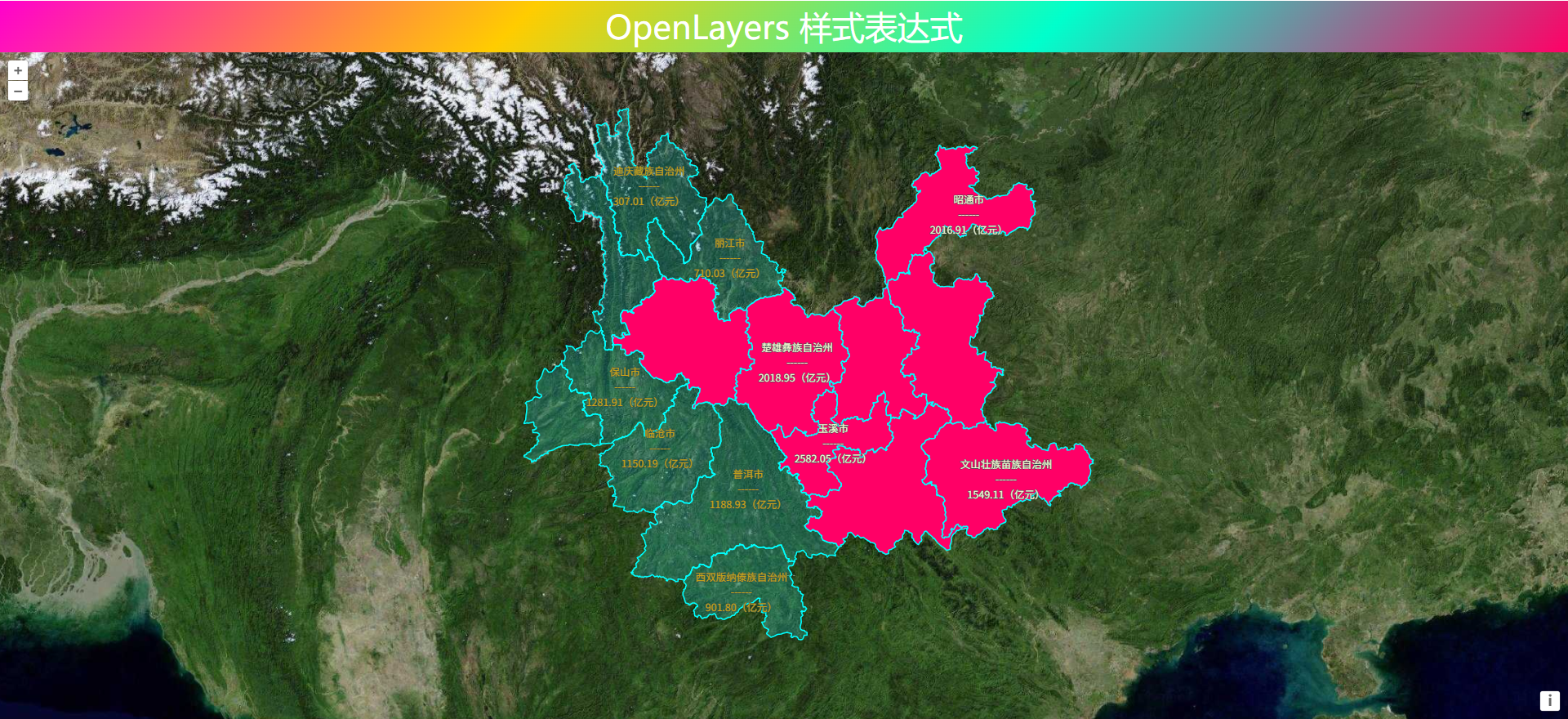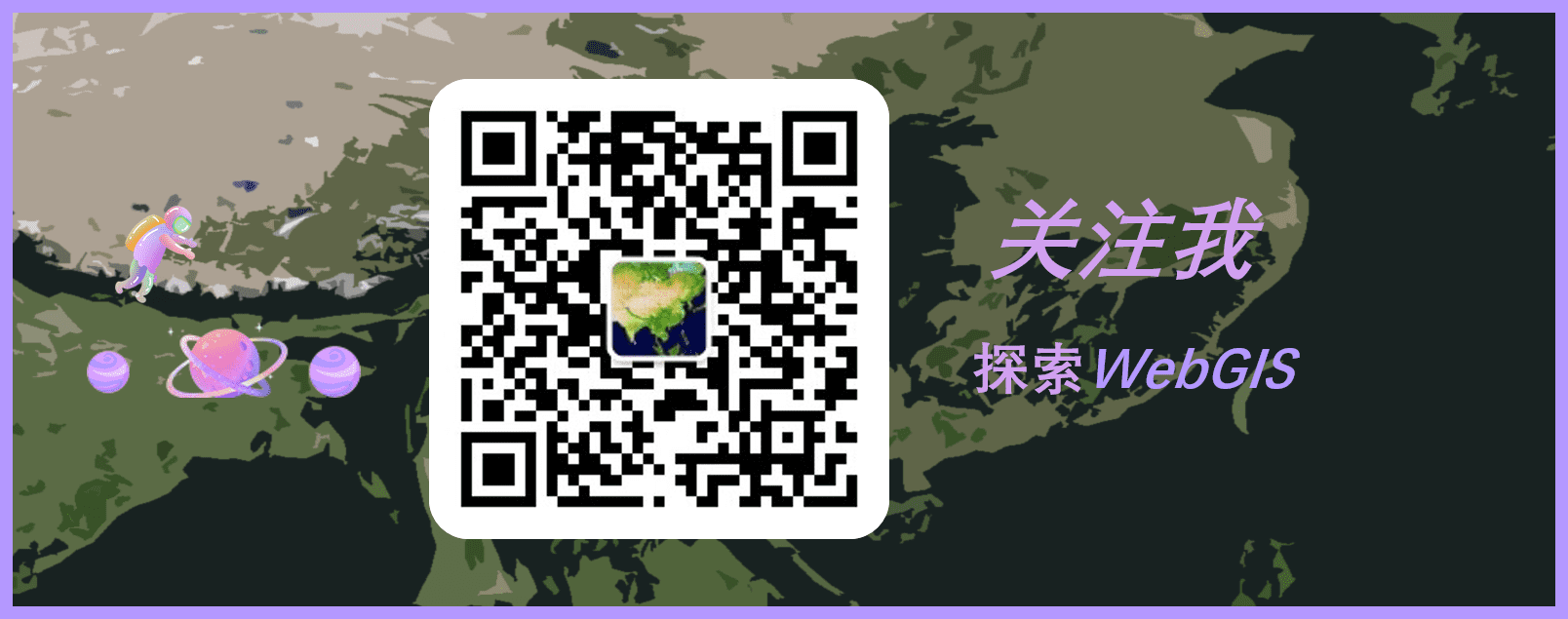^ 关注我,带你一起学GIS ^
注:当前使用的是 ol [9.2.4] 版本,天地图使用的key请到天地图官网申请,并替换为自己的key
 前言
前言
页面交互的复杂度体现系统使用的难易程度,在开发WebGIS系统过程中,总会涉及要素操作,如何设计才能使交互操作变得简洁呢?OpenLayers提供了一些成熟的交互控件可以做到,并且可以自定义交互事件。
1. 自定义交互类
创建拖动类Drag,并继承ol.interaction.Pointer类。在构造函数中初始化使用super函数初始化鼠标事件,然后设置坐标和鼠标样式。
PointerInteraction作为用户定义事件down、move、up的基类,管理着事件“拖动序列”。
当用户定义事件函数handleDownEvent返回true时,开始拖动序列,在拖动序列中,事件函数handleDragEvent在移动事件中被调用,当事件函数handleUpEvent被调用并返回false时,拖动序列结束。
class Drag extends ol.interaction.Pointer {
constructor() {
super({
handleDownEvent,
handleDragEvent,
handleMoveEvent,
handleUpEvent
})
// 要素坐标
this.coordinate_ = null
// 鼠标样式
this.cursor_ = 'pointer'
// 移动前鼠标样式
this.previousCursor_ = undefined
// 移动要素
this.feature_ = null
}
}
2. 鼠标交互事件
2.1. 鼠标按下事件
在鼠标按下事件中查询当前像素坐标点要素,从事件参数event中获取到map对象,通过调用forEachFeatureAtPixel方法获取目标位置要素对象,该方法接受两个参数,一个目标点象数坐标,另一个参数为函数对象,在该函数中返回查询要素。
如果在鼠标按下事件中查询到要素对象,则保存当前位置坐标和查询要素,设置返回条件为仅当查询到要素时才返回true,即当返回值为true时才可以进行拖动。
// 鼠标按下事件,返回'true'开始拖动
function handleDownEvent(evt) {
const map = evt.map
const feature = map.forEachFeatureAtPixel(evt.pixel, function (feature) {
return feature
})
if (feature) {
this.coordinate_ = evt.coordinate
this.feature_ = feature
}
// 仅当查询到要素时才可以进行拖动
return !!feature
}
2.2. 鼠标拖动事件
在鼠标拖动事件中需要计算要素拖动距离,在移动事件中可以获取当前移动的鼠标坐标,将当前X、Y坐标和目标要素坐标做差得出偏移距离,然后获取到要素几何对象,通过translate方法设置几何对象偏移。最后更新要素坐标值。
// 鼠标拖动事件
function handleDragEvent(evt) {
// 计算拖动距离
const deltaX = evt.coordinate[0] - this.coordinate_[0]
const deltaY = evt.coordinate[1] - this.coordinate_[1]
const geometry = this.feature_.getGeometry()
geometry.translate(deltaX, deltaY)
// 更新位置坐标
this.coordinate_[0] = evt.coordinate[0]
this.coordinate_[1] = evt.coordinate[1]
}
2.3. 鼠标移动事件
在鼠标移动事件中切换鼠标样式。在查询到要素对象时,设置鼠标样式为自定义样式,并保存地图对象原来鼠标样式,在未查询到要素对象时恢复原来的鼠标样式。
// 鼠标移动事件
function handleMoveEvent(evt) {
if (this.cursor_) {
const map = evt.map
const feature = map.forEachFeatureAtPixel(evt.pixel, function (feature) {
return feature
})
// 获取地图对象绑定HTMLElement
const element = map.getTargetElement()
if (feature) {
if (element.style.cursor !== this.cursor_) {
this.previousCursor_ = element.style.cursor
element.style.cursor = this.cursor_
}
} else if (this.previousCursor_ !== undefined) {
element.style.cursor = this.previousCursor_
this.previousCursor_ = undefined
}
}
}
2.4. 鼠标释放事件
在鼠标释放事件中返回false,重置要素和坐标值,结束拖动事件。
// 鼠标松开事件
function handleUpEvent(evt) {
this.feature_ = null
this.coordinate_ = null
return false
}
3. 加载拖动交互事件
加载交互事件有很多种方式,可以使用addInteraction方式加载,也可以获取交互对象进行加载。具体加载方式可以参考:OpenLayers 移动要素:
4. 完整代码
其中libs文件夹下的包需要更换为自己下载的本地包或者引用在线资源。
<!DOCTYPE html>
<html>
<head>
<meta http-equiv="Content-Type" content="text/html; charset=utf-8" />
<title>OpenLayers 拖拽缩放和旋转</title>
<meta charset="utf-8" />
<link rel="stylesheet" href="../../libs/css/ol9.2.4.css">
<script src="../../js/config.js"></script>
<script src="../../libs/js/ol9.2.4.js"></script>
<style>
* {
padding: 0;
margin: 0;
font-size: 14px;
font-family: '微软雅黑';
}
html,
body {
width: 100%;
height: 100%;
}
#map {
position: absolute;
top: 50px;
bottom: 0;
width: 100%;
}
#top-content {
position: absolute;
width: 100%;
height: 50px;
line-height: 50px;
background: linear-gradient(135deg, #ff00cc, #ffcc00, #00ffcc, #ff0066);
color: #fff;
text-align: center;
font-size: 32px;
}
#top-content span {
font-size: 32px;
}
</style>
</head>
<body>
<div id="top-content">
<span>OpenLayers 自定义拖拽事件</span>
</div>
<div id="map" title="地图显示"></div>
</body>
</html>
<script>
//地图投影坐标系
const projection = ol.proj.get('EPSG:3857');
//==============================================================================//
//============================天地图服务参数简单介绍==============================//
//================================vec:矢量图层==================================//
//================================img:影像图层==================================//
//================================cva:注记图层==================================//
//======================其中:_c表示经纬度投影,_w表示球面墨卡托投影================//
//==============================================================================//
const TDTImgLayer = new ol.layer.Tile({
title: "天地图影像图层",
source: new ol.source.XYZ({
url: "http://t0.tianditu.com/DataServer?T=img_w&x={x}&y={y}&l={z}&tk=" + TDTTOKEN,
attibutions: "天地图影像描述",
crossOrigin: "anoymous",
wrapX: false
})
})
const TDTImgCvaLayer = new ol.layer.Tile({
title: "天地图影像注记图层",
source: new ol.source.XYZ({
url: "http://t0.tianditu.com/DataServer?T=cia_w&x={x}&y={y}&l={z}&tk=" + TDTTOKEN,
attibutions: "天地图注记描述",
crossOrigin: "anoymous",
wrapX: false
})
})
const map = new ol.Map({
target: "map",
loadTilesWhileInteracting: true,
view: new ol.View({
center: [102.845864, 25.421639],
zoom: 5,
worldsWrap: false,
minZoom: 1,
maxZoom: 20,
projection: 'EPSG:4326',
}),
layers: [TDTImgLayer, TDTImgCvaLayer],
// 地图默认控件
controls: ol.control.defaults.defaults({
zoom: false,
attribution: false,
rotate: false
}),
// interactions: ol.interaction.defaults.defaults().extend([new Drag()])
})
map.on('click', evt => {
console.log("获取地图坐标:", evt.coordinate)
})
class Drag extends ol.interaction.Pointer {
constructor() {
super({
handleDownEvent,
handleDragEvent,
handleMoveEvent,
handleUpEvent
})
// 要素坐标
this.coordinate_ = null
// 鼠标样式
this.cursor_ = 'pointer'
// 移动前鼠标样式
this.previousCursor_ = undefined
// 移动要素
this.feature_ = null
}
}
// 鼠标按下事件,返回'true'开始拖动
function handleDownEvent(evt) {
const map = evt.map
const feature = map.forEachFeatureAtPixel(evt.pixel, function (feature) {
return feature
})
if (feature) {
this.coordinate_ = evt.coordinate
this.feature_ = feature
}
// 仅当查询到要素时才可以进行拖动
return !!feature
}
// 鼠标拖动事件
function handleDragEvent(evt) {
// 计算拖动距离
const deltaX = evt.coordinate[0] - this.coordinate_[0]
const deltaY = evt.coordinate[1] - this.coordinate_[1]
const geometry = this.feature_.getGeometry()
geometry.translate(deltaX, deltaY)
// 更新位置坐标
this.coordinate_[0] = evt.coordinate[0]
this.coordinate_[1] = evt.coordinate[1]
}
// 鼠标移动事件
function handleMoveEvent(evt) {
if (this.cursor_) {
const map = evt.map
const feature = map.forEachFeatureAtPixel(evt.pixel, function (feature) {
return feature
})
const element = map.getTargetElement()
if (feature) {
if (element.style.cursor !== this.cursor_) {
this.previousCursor_ = element.style.cursor
element.style.cursor = this.cursor_
}
} else if (this.previousCursor_ !== undefined) {
element.style.cursor = this.previousCursor_
this.previousCursor_ = undefined
}
}
}
// 鼠标松开事件
function handleUpEvent(evt) {
this.feature_ = null
this.coordinate_ = null
return false
}
map.getInteractions().extend([new Drag()])
// 创建要素对象
const pointFeature = new ol.Feature(new ol.geom.Point([
90.45461480466271,
28.27171566587066
]))
const lineStringFeature = new ol.Feature(new ol.geom.LineString([
[98.06070935932541, 31.773693479057368],
[98.06070935932541, 18.823243159290566]
]))
const polygonFeature = new ol.Feature(new ol.geom.Polygon([
[
[105.62320775, 30.401227753660713],
[114.27164739576722, 30.471610903957952],
[114.27164739576722, 21.920091032793525],
[105.62320775, 20.934729613526073]
]
]))
// 创建矢量数据源
const vectorSource = new ol.source.Vector({
features: [pointFeature, lineStringFeature, polygonFeature]
})
// 创建矢量图层
const vectorLayer = new ol.layer.Vector({
source: vectorSource,
style: {
'icon-src': '../../image/point.png',
// 'icon-size':[100,100],
'icon-scale': 5,
// 'icon-opacity': 0.95,
// 'icon-anchor': [0.5, 46],
'icon-anchor-x-units': 'fraction',
'icon-anchor-y-units': 'pixels',
'stroke-width': 5,
'stroke-color': [0,255,204, 1],
'fill-color': [255,204,0, 0.6],
}
})
map.addLayer(vectorLayer)
</script>
❝
OpenLayers示例数据下载,请在公众号后台回复:ol数据
全国信息化工程师-GIS 应用水平考试资料,请在公众号后台回复:GIS考试
❝
GIS之路公众号已经接入了智能助手,欢迎大家前来提问。
欢迎访问我的博客网站-长谈GIS:
http://shanhaitalk.com
都看到这了,不要忘记点赞、收藏+关注 哦!
本号不定时更新有关 GIS开发 相关内容,欢迎关注 


